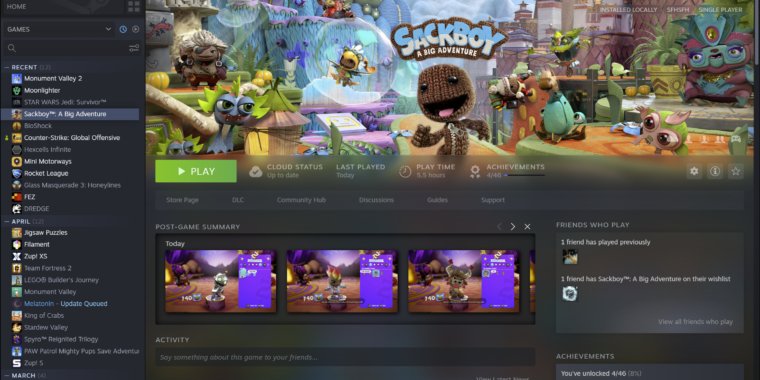-
This is the new library view. The interface isn’t all that different functionally, but it does have a fresh coat of paint.
Valve
-
Bigger changes came to the in-game overlay.
Valve
-
You can now take notes for each game from the overlay.
Valve
-
You can create notes (as well as other overlay windows) with adjustable transparency levels.
Valve
-
Some minor changes have been made to notifications to make them less overwhelming.
Valve
PC gamers could easily joke that three things in life never change: death, taxes, and the classic look of Steam. However, one of those things just changed; Valve just released the most substantial overhaul of Steam in years, including a visual makeover and several new features.
Further, the company has brought the Mac and Linux versions of Steam closer to par with the historically superior Windows version.
Valve says “the most impactful changes” are actually under the hood. The company’s developers have made an effort to achieve more consistency between how things work in Steam for desktop, the TV-oriented Big Picture mode, and Steam Deck. This codebase revision means that new features coming to the desktop version of Steam can be shipped simultaneously on Steam Deck with minimal effort.
In terms of things visible to users, the look and feel of the entire application has been overhauled and modernized. In most cases, things are more or less where they were in the interface: they just look a little different, with new fonts, colors, sizes, and so on.
That said, the in-game overlay has received a bigger overhaul, as have notifications.
Steam users have access to more customizations on how and when notifications appear, and the notification panel displays only new notifications, with a “view all” button to dig into older ones.
In general, the overlay contains more information about the game you’re playing, from achievement progress to playing time and beyond. Valve has made major changes to the Steam Deck’s controller configurator, which is now part of the overlay when a game is connected.
The overlay is also home to perhaps the most substantial user-facing feature: the ability to take notes in the Steam overlay while playing a game. The notes are linked to that game, you can write multiple notes per game, and they support rich text formatting.
It doesn’t stop there. You can now pin individual windows of the Steam overlay so that they appear on top of your game even when the overlay is closed, and you can adjust the transparency of these windows to your liking. This works not only for notes, but also for achievements, the web browser, manuals and discussions.
That all applies to the Windows, Mac, and Linux versions of Steam. Additionally, Steam now supports hardware acceleration on macOS and Linux. That means these versions have reached parity with Windows for the first time.
If you’ve ever used Steam on Mac or Linux before, you know that for a long time it felt both slow and clunky. That is no longer the case. It’s a day and night improvement on those platforms.
These changes were rolled out this week and should now be available to all users.
List image by Valve

